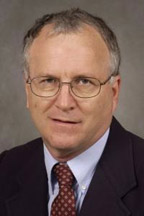Professor
Director, Chronobiology Laboratory
Phone: (631) 444-1613
The rest/activity cycle of mammals is generated by a master clock in the hypothalamic suprachiasmatic nucleus (SCN). This clock provides circadian (approximately 24 hr) timing information to the brain and body. The SCN is the target of 3 major regulatory pathways. It receives direct sensory input from the retina via the retinohypothalamic tract (RHT), a specialized visual pathway, and indirect photic and nonphotic information arriving through the geniculohypothalamic tract (GHT) that originates in the thalamic intergeniculate leaflet (IGL). The IGL itself is directly retinorecipient and is extensively connected to other midbrain visual nuclei. Information is relayed from the IGL to the SCN through neurotensin-, neuropeptide Y-, enkephalin- or GABA-containing neurons. The third major SCN-afferent projection is the raphe serotonergic system. Serotonin modulates the responsiveness of SCN neurons to light. The SCN, under the influence of these and other input pathways, serves to synchronize behavioral and physiological rhythms with the environmental photoperiod. Each of the above brain nuclei has numerous other efferent and afferent connections. The goals of this laboratory have been to (A) describe the neuroanatomical sources of input to the circadian rhythm system; (B) discern the functions of those inputs; and (C) understand the efferent pathways by which the circadian clock might regulate the timing of behavior and physiology. Of particular interest at the moment is the ability of light to modify several different functions of neural systems including circadian clock phase, locomotion suppression, sleep induction and temperature control. The long term goal of this project has been to establish comprehensive understanding of the methods and anatomical routes by which various classes of environmental stimuli can modulate phase and period of the circadian clock.
| Education: | |||
| PhD (Psychobiology) | Rutgers University, Institute of Animal Behavior | ||
| Post Doctoral Research Fellowship | University of California, Berkeley | ||
| Research Interests: | circadian rhythms neuroanatomy non-image forming visual system effects of light sleep thermoregulation |
||
| Publications: | Medline Search | ||
| New! |
Research article:
Retinofugal Projections in the Mouse. Journal of Comparative Neurology Published on line May 30, 2014 Research article: Brief light stimulation during the mouse nocturnal activity phase simultaneously induces a decline in core temperature and locomotor activity followed by EEG-determined sleep. Ameerican Journal of Physiology, 304(6):R459-71. Epub 2013 Jan 30 Research article: Neuroanatomy of the extended circadian rhythm system, Experimental Neurology 2013, Epub 2012 Jul 2. |
||


